Navigating Treatment Choices
Subcategories
Navigating the Food Allergy Treatment Decision Process
Considering or deciding to pursue management of a food allergy is a major decision that may result in mixed emotions. Therefore, this informational handout aims to offer guidance on navigating the exploration process and psychological considerations associated with food allergy treatments.
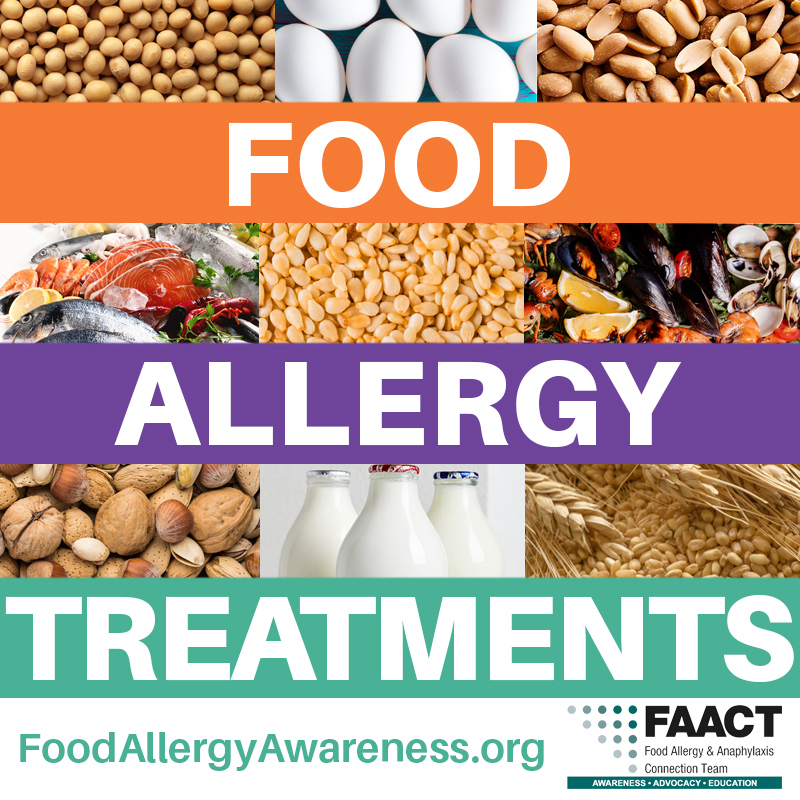
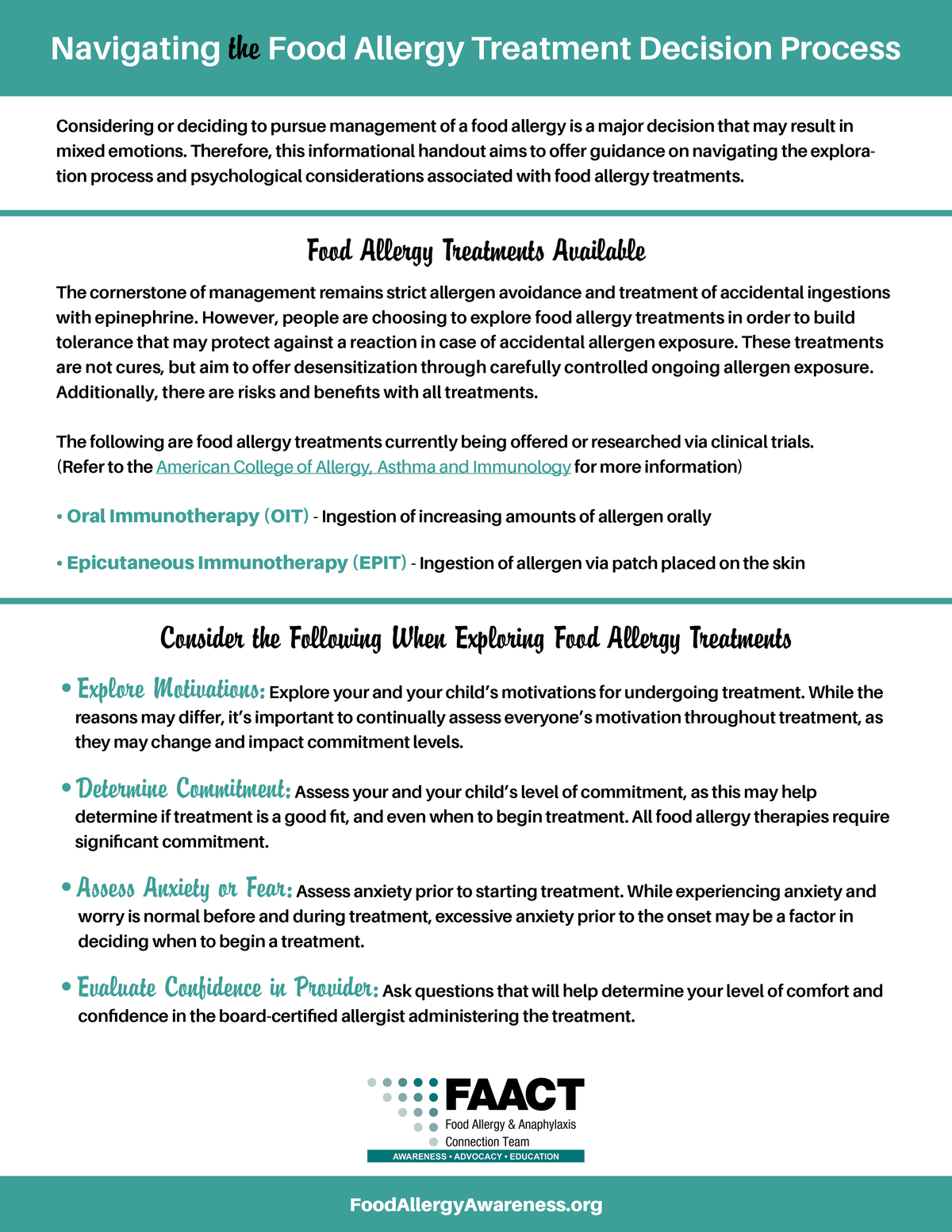
Food Allergy Treatments Available
Treatments for food allergies are evolving, and while there isn't yet a complete cure, several approaches are available to manage and potentially reduce the severity of allergic reactions through carefully controlled ongoing allergen exposure. There are risks and benefits with all treatments.
Here’s a summary of the current food allergy treatment options:
1. Avoidance and Emergency Management
- Strict Avoidance: The primary method of managing food allergies is to avoid the allergenic food completely.
- Emergency Medications: Individuals with food allergies are advised to carry two, FDA-approved epinephrine products (e.g., Auvi-Q®, EpiPen® or nasal spray neffy®) to treat anaphylactic reactions, along with antihistamines for milder reactions.
2. Oral Immunotherapy (OIT)
- Description: OIT involves gradually consuming increasing amounts of the allergenic food under medical supervision to build tolerance. This can potentially raise the threshold at which a reaction occurs, reducing the severity of accidental exposure.
- Approved Treatments: The FDA has approved an oral immunotherapy treatment for peanut allergies, called Palforzia for ages 1 to 17. It is administered as a powder inside a capsule; capsule is not ingested - the contents are mixed with food.
- Other: Other OITs are used off-label for different allergens.
3. Epicutaneous Immunotherapy (EPIT)
- Description: EPIT involves the application of a patch containing small amounts of the allergen (e.g., peanut) on the skin. The allergen is absorbed through the skin to desensitize the immune system.
- Current Status: Clinical trials are ongoing, with some promising results, particularly for peanut allergies.
4. Sublingual Immunotherapy (SLIT)
- Description: SLIT involves placing a small amount of the allergen extract under the tongue. Like OIT, it aims to desensitize the immune system but typically involves lower doses.
- Current Use: It is less common than OIT but is being explored/used as a treatment option for certain food allergies.
5. Biologics and Medication
- Anti-IgE Therapy: Medications like omalizumab (Xolair) work by targeting and neutralizing IgE antibodies, which are responsible for allergic reactions. It is administered via subcutaneous injection every 2 to 4 weeks. This therapy can be used as monotherapy or alongside OIT to reduce the risk of reactions.
- Other Medications: Research is ongoing into other biologic drugs that might prevent or reduce the severity of allergic reactions by targeting different aspects of the immune response.
6. Dietary Supplements and Probiotics
- Probiotics and Prebiotics: Some research suggests that gut microbiome modulation through probiotics and prebiotics might play a role in reducing the severity of food allergies or aiding in desensitization therapies, though this area is still in early stages.
7. Emerging Therapies
- Gene Therapy: Although still experimental, gene therapy holds promise as a potential cure for food allergies by correcting the underlying immune system dysfunction.
- T-Cell Therapies: Experimental treatments aiming to modify T-cell responses to allergens are also being researched.
8. Prevention in Infants
- Early Introduction: Guidelines now recommend the early introduction of allergenic foods (like peanuts) to infants at high risk of allergies as a preventive measure, based on studies that have shown this can significantly reduce the risk of developing allergies.
9. Clinical Trials and Experimental Therapies
- Ongoing Research: There are numerous clinical trials underway exploring new approaches, combinations of therapies, and better understanding of how to prevent or cure food allergies.
Each of these options has its own risks, benefits, and suitability depending on the individual’s specific allergies, age, and overall health. Management and treatment plans should always be discussed with a board-certified allergist.
Other Recent Publications
-
The Immune Tolerance Network IMPACT trial funded by the NIH involving ~150 children found that giving peanut OIT to highly peanut-allergic children ages 1-3 years safely desensitized most of them to peanut and induced remission of peanut allergy in 21% of participants. Maintenance was 6 peanuts (2g) for ~2.5 years. Remission defined as being able to eat 16 peanuts (5g) of peanut protein, without having an allergic reaction 6 months after completing immunotherapy. Lower levels of peanut-specific IgE at the start of the trial and being younger predicted whether a child would achieve remission. Nearly all participants had at least one dose-related reaction during treatment, most were mild to moderate in severity. 21 children received epinephrine for 35 moderate reactions.
Interpretation: Initiation of OIT before age 4 was associated with an increase in both desensitization and remission. Development of remission correlated with immunological biomarkers. There is window of opportunity at a young age for intervention to induce remission of peanut allergy.
Jones SM, et al; Immune Tolerance Network. Efficacy and safety of oral immunotherapy in children aged 1-3 years with peanut allergy (the Immune Tolerance Network IMPACT trial): a randomized placebo-controlled study.
Lancet. 2022 Jan 22;399(10322):359-371.
-
The Peanut Allergy Burden Study (PABS) is a cross-sectional quantitative survey designed to determine the real-world experience of patients and caregivers with PA. The objective of the study was to understand the real-world utilization of PArelated healthcare resources and the impact of PA on productivity.
Conclusion: many healthcare resources were utilized by patients with PA and there was a loss of productivity associated with PA for patients and caregivers.
McCann W, World Allergy Organ J. 2021 Mar 26;14(3):100525.
-
Open-label follow-up of Palforzia: the benefit of daily administration of Palforzia has been established in clinical trials, but limited data past the first year of treatment are available. This longitudinal analysis aimed to explore the impact of continued Palforzia maintenance dosing (300 mg/day) on efficacy, safety/tolerability, and food allergy-related quality of life.
Conclusion: daily treatment with Palforzia beyond 1 year leads to an improved safety/tolerability profile and continued clinical and immunological response.
Fernandez-Rivas M, Pub Med. 2022 Mar;77(3):991-1003. doi: 10.1111/all.15027.
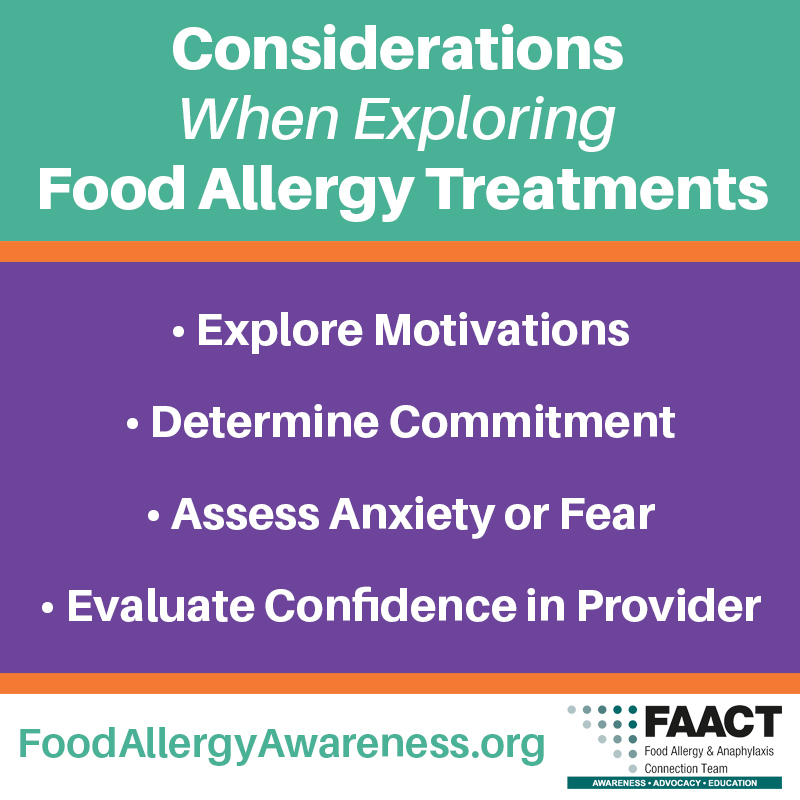
Considerations When Exploring Food Allergy Treatments
Explore Motivations:
Explore your and your child’s motivations for undergoing treatment. While the reasons may differ, it’s important to continually assess everyone’s motivation throughout treatment, as they may change and impact commitment levels.
Determine Commitment:
Assess your and your child’s level of commitment, as this may help determine if treatment is a good fit, and even when to begin treatment. All food allergy therapies require significant commitment.
Assess Anxiety or Fear:
Assess anxiety prior to starting treatment. While experiencing anxiety and worry is normal before and during treatment, excessive anxiety prior to the onset may be a factor in deciding when to begin a treatment.
Evaluate Confidence in Provider:
Ask questions that will help determine your level of comfort and confidence in the board-certified allergist administering the treatment.
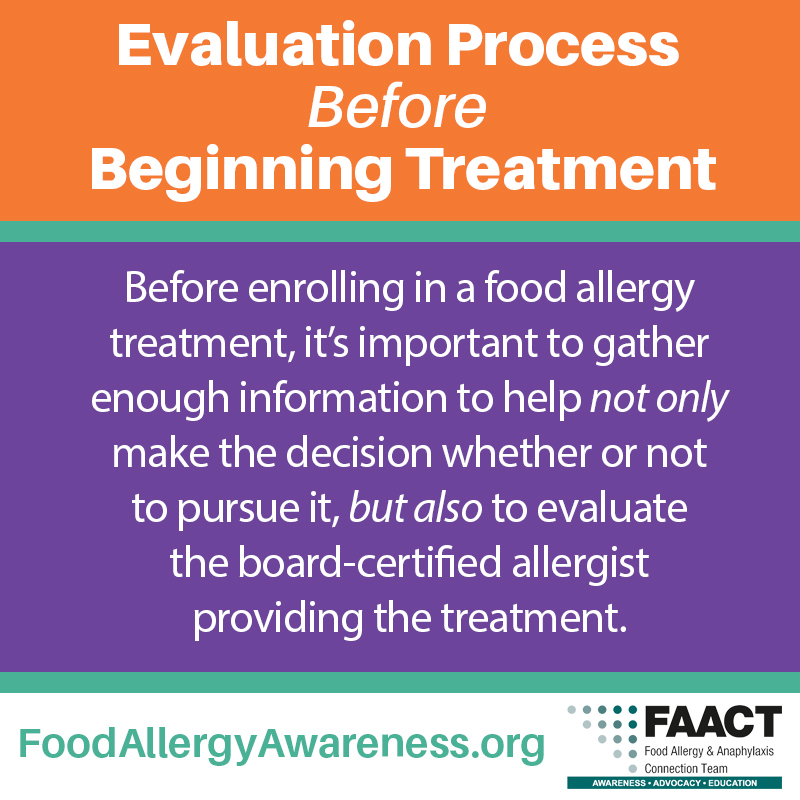
Evaluation Process Before Beginning Treatment
Before enrolling in a food allergy treatment, it’s important to gather enough information to help not only make the decision whether or not to pursue it, but also to evaluate the board-certified allergist providing the treatment. Below is a question guide to help navigate this evaluation process.
Treatment & Provider Information:
• What are the goals, expected outcomes, and specific protocols for treatment?
• Are oral food challenges required to confirm the allergy before starting treatment?
• Are oral food challenges required to determine effectiveness of the trearment?
• What is the follow-up or maintenance protocol after treatment?
• What is required of you/your child (i.e. appointment frequency, daily protocols)?
• Will treatment impact school, work, activities, or daily routines, and if so, how?
• How are viruses or illnesses navigated while taking part in the treatment?
• How does the provider address treatment-related anxiety that may arise?
• How familiar is the provider with the treatment?
Potential Benefits & Risks of Treatment:
• What are the potential risks and benefits of the treatment, medical or otherwise?
• Are anaphylactic reactions a potential risk of treatment?
• What are potential treatment setbacks, their likelihood, and how they are handled?
Office Procedures:
• Will appointments be with the provider, or associates within the practice?
• Is a provider on call 24 hours/day in case of emergencies?
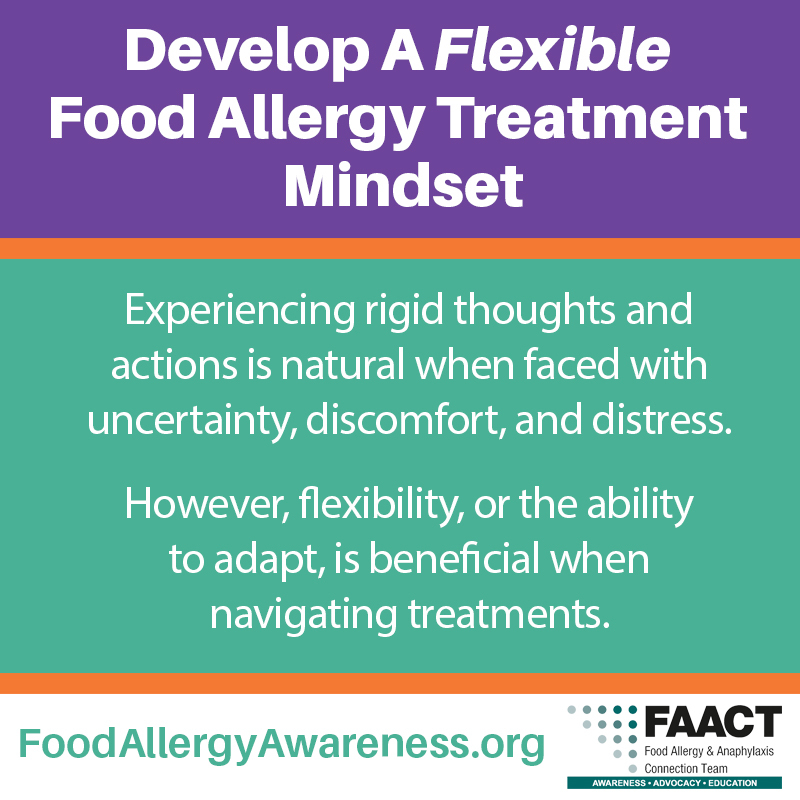
Develop A Flexible Food Allergy Treatment Mindset
Experiencing rigid thoughts and actions is natural when faced with uncertainty, discomfort, and distress. However, flexibility, or the ability to adapt, is beneficial when navigating treatments.
The following tips can help establish a flexible mindset and approach to food allergy treatments:
• Establish open communication with your board-certified allergist and treatment team.
• Engage in shared decision-making to develop treatment timeline and goals.
• Understand that treatment is a process rather than just a desired outcome.
• Prepare for the possibility of setbacks, the need to alter approaches, or stop treatment
• Monitor anxiety levels, reaching out for counseling or support services if excessive.

